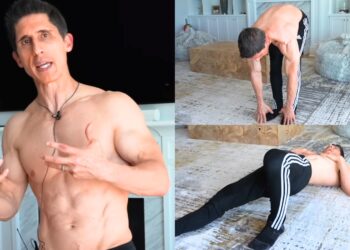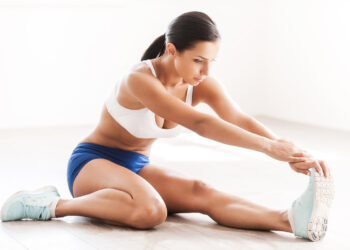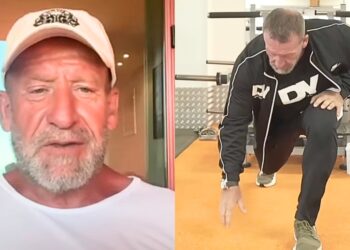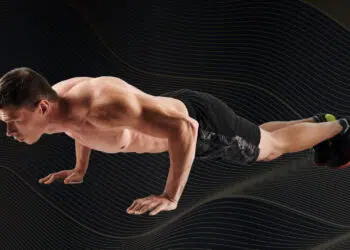Many people have a hard time performing compound lower body exercises like the squat, lunge, and Romanian deadlift because of a lack of mobility and muscular stiffness.
Adding yoga poses to your daily regimen can help improve your performance in the gym by boosting your flexibility and enhancing your core strength. Plus, better mobility can also make you better at daily activities.
The frog stretch (mandukasana) is one of the most effective yoga poses to improve your lower body mobility. It targets your core, hips, and inner thighs. This pose is also known as the downward-facing frog.
What is a Frog Stretch?
The frog stretch, also known as mandukasana, is a group of seated asanas in hatha yoga and modern yoga as exercise. These poses make your body resemble a frog.
Mandukasana is made from two Sanskrit words, manduk meaning frog and asana meaning pose. The pose involves laying on your stomach with your thighs turned out and flat against the ground, resembling a swimming frog.
The frog stretch requires practice and flexibility. It helps release muscle tightness in your hips, core, groin, and adductors and reduces knee strain. Furthermore, it helps reduce hip, knee, or back pain.
Level Up Your Fitness: Join our 💪 strong community in Fitness Volt Newsletter. Get daily inspiration, expert-backed workouts, nutrition tips, the latest in strength sports, and the support you need to reach your goals. Subscribe for free!
Notably, since the frog stretch is a form of static stretching, it is best performed at the end of your training regimen. According to research, dynamic stretches are best done at the end of a workout as they lengthen your muscles and reduce muscle strength, which raises your risk of injury while training. [1]
On the flip side, dynamic stretching can prepare your body for a workout by helping to loosen and warm up your muscles. [2]
Frog Stretch Exercise: Muscles Worked
The frog stretch is a static exercise that works the adductors, groin muscles, lower back, shoulders, core, and hips.
To get the best bang for your buck, hold the pose for as long as possible and focus on contracting these muscles. Yoga involves focusing on your breathing while performing the poses, so ensure that you are mindful of your breath while doing this hip opener.
Benefits of Frog Stretch
Given below are the benefits of adding the frog stretch to your routine:
1. Improves Hip Mobility and Eases Lower Back Stiffness
These are the two most common reasons people add the frog stretch to their exercise regimens. This pose requires you to place your face on an exercise mat and spread your hips and legs wide by scooting your knees on the floor. The exercise setup results in better lower body mobility and reduced lower back pain and stiffness.
The frog stretch is a must-do for people who spend most of their days seated. It helps undo the damage caused by sitting with an incorrect posture for an extended duration. Performing the frog stretch daily can improve your flexibility, mobility, and range of motion, boosting your daily functioning.
2. Helps Build a Stronger Core
Doing the frog stretch regularly can help strengthen your pelvic muscles and core. Many yoga practitioners claim that this pose can improve your sex drive, although more research is needed to verify these claims. [3]
3. Boosts Blood Circulation
The frog pose opens your chest, improving your lung function and allowing more oxygen flow. Plus, research suggests that meditative practices can help reduce blood pressure, aiding in better blood flow. [4]
4. Improves Mental Health
As mentioned above, yoga exercises require you to focus on your breathing. This can help reduce stress and anxiety and improve your mental health. [5]
5. Enhances Digestive Health
The frog stretch stimulates internal organs like the kidneys, intestines, and liver, which can improve your digestive system [6]. The frog stretch can also help in treating constipation and indigestion.
How To Perform Frog Stretch
This is how to perform the frog stretch with the perfect form:
- In a quadruped position, ensure your hands are under your shoulders and your knees are beneath your hips.
- Transfer your weight onto your hands.
- Slowly spread your knees as wide as possible while keeping them in line with your hips.
- Your upper legs should be at a 90-degree angle with your lower legs. Turn your toes out to the sides.
- Now, lower your upper body onto your forearms. Your elbows should be below your shoulders. Alternatively, you could extend your arms straight in front of you and rest your chin or forehead on the floor.
- While taking a deep breath, push your hips back as far as possible.
- Focus on relaxing your muscles while breathing out at the bottom.
- Return to the starting with a slow and controlled motion.
- Repeat for recommended repetitions.
Pro Tips
- Since the frog stretch is a deep stretch exercise, ensure you are warmed up before performing this pose.
- Move your hips back and forth to loosen up the target muscles.
- Keep your head and torso in a straight line to avoid unnecessary tension on your neck.
- Use a cushioned exercise mat for this exercise, as performing the frog stretch on a hard surface can cause knee discomfort.
- Release the pose if you feel discomfort or pain in your abdomen or lower body.
- Don’t try to force your knees apart, especially when you are starting. Take your time to build mobility in your lower body.
This Exercise:
- Target Muscle Group: Adductors
- Secondary Muscles: Hips, groin muscles, and core
- Type: Warmup
- Mechanics: Static
- Equipment: Bodyweight
- Difficulty: Beginner to Advanced
- Best Rep Range: 1-5 minutes
Common Mistakes While Performing Frog Stretch
Although the frog stretch looks relatively easy, most people perform it incorrectly. Here are some of the most common mistakes people commit while doing the frog stretch:
1. Position of Your Legs
Your legs should be in the correct position to get the most out of this exercise. Your knees should be in line with your hips, your lower legs should be at a 90-degree angle with your upper legs, and your feet should be touching the floor and pointing outward.
Ensure that your upper legs are not too high or low and your lower legs are not caving in.
Level Up Your Fitness: Join our 💪 strong community in Fitness Volt Newsletter. Get daily inspiration, expert-backed workouts, nutrition tips, the latest in strength sports, and the support you need to reach your goals. Subscribe for free!
2. Forcing Your Knees
This is a rookie mistake. When folks who lack lower body mobility attempt this exercise, they try to get into position by forcing their knees to the sides and jerking their hips to lower toward the floor. Not forcing your knees wider than they naturally go can help you save from adductor and groin injury.
3. Dropping Your Lower Back
Many people drop their lower back while performing the frog stretch to get a better adductor stretch. However, this can be counterproductive and put your lower back under undue stress. Also, ensure that you are not rounding your back.
4. Not Breathing Right
The frog stretch is a yoga pose, meaning you cannot overlook the breathing aspect of this exercise. Breathe deeper as you achieve a deeper stretch. It will help improve your circulation and maintain core stability.
5. Not Using Proper Tools
The frog stretch requires you to balance your body weight on your knees and elbows, which can be painful if you are not used to it or are doing it on a hard surface. Make the most of this exercise by performing it on a cushioned surface or using folded blankets under your knees and elbows to reduce strain.
Variations and Alternatives of Frog Stretch
Here are some frog stretch variations and alternatives that you could add to your exercise arsenal:
1. Half Frog
The half-frog is a stepping stone to the frog pose. It will help build mobility in your lower body. Practice this exercise for four weeks before switching to the frog stretch.
Steps:
- Lie prone on an exercise mat.
- Place your elbows under your shoulders.
- Extend your chest by drawing back your shoulders.
- Bend your left leg at your knee to bring the heel as close to your glutes as possible.
- Reach back with your left hand and grab the top of your left foot.
- Get your heel as close to your butt as possible. Align your left elbow above your left foot so it’s pointing up.
- Hold for a minute.
- Return to the starting position and repeat with the other leg.
Pro Tip: Ensure your foot is above your hip at the top of the movement. Do not bring it to the side of your butt.
2. Happy Baby
The happy baby pose helps build inner thigh flexibility, which can carry over to the frog stretch.
Steps:
- Lie supine on an exercise mat.
- Pull your knees up to your chest. Your lower legs should be perpendicular to the floor.
- Grip the outsides of your feet.
- Spread your knees as wide as possible. They should be at least wider than your torso.
- Press your feet into your hands to make the exercise harder.
- Hold for 60 seconds.
Pro Tip: Once the 60 are up, extend your knees for a better hamstring engagement. Hold this pose for an additional 30 seconds.
3. Wide Child Pose
As you might have guessed by now, the child poses are your key to the frog stretch. This pose improves your adductor, glutes, ankles, and back mobility.
Steps:
- Start in a quadruped position. Your hands should be under your shoulders; spread your knees as wide as possible, keeping the tops of your feet on the floor with the big toes touching.
- Drive your hips back so your belly rests between your thighs; your forehead touches the floor.
- Keep your arms extended in front of you with your palms facing the floor.
- Try to feel a contraction in your target muscles.
- Hold the position for as long as possible.
Pro Tip: Place your arms wide on the exercise mat for better upper-body engagement during the static contraction.
4. Downward Facing Dog
The downward facing dog is one of the most popular yoga poses. This pose helps loosen up the entire posterior chain.
Steps:
- Get into a tabletop position. Plant your wrists slightly in front of your shoulders and your knees underneath your hips.
- Spread your fingers and push back through your hands while curling your toes to lift your hips and straighten your legs.
- Let your head hang and pull back your shoulder blades.
- Contract your quads to lessen the burden on your arms.
- Rotate your thighs inward, keep your tail high, and sink your heels towards the floor.
- Pause at the top for 30-60 seconds.
- Slowly return to the starting position.
Pro Tip: Ensure your knees are extended at the top for optimal lower body engagement. Even a slight bend in your knees can take away tension from your hamstrings.
5. Thread the Needle
Upper body mobility plays an important role in the frog stretch. Thread the needle pose will help improve your upper body flexibility.
Steps:
- Get into a quadruped position with your hands under your shoulders and your knees under your hips. Tuck your toes under.
- Open your chest to the right and extend your right arm toward the ceiling. Direct your gaze toward your raised hand. Keep your left hand planted on the floor.
- Slowly return to the starting position and move your right arm under your chest toward the mat.
- At the bottom, your right arm should be perpendicular to your torso, and the outside of your right shoulder should be on the floor under your left shoulder. Rest your right ear and cheek on the floor.
- Hold this pose for 30-60 seconds.
- Return to the starting position.
- Repeat on the left side.
- Alternate between sides for recommended reps.
Pro Tip: Raise your supporting arm toward the ceiling at the bottom static contraction for better upper body engagement.
Frequently Asked Questions
Who should avoid the frog stretch?
Although the frog stretch is a safe exercise for most people, it can cause discomfort to people dealing with knee, hip, or lower back injuries or weakness. Furthermore, you should avoid the frog stretch if you recently underwent abdominal surgery. Consult your physician before engaging in physical exercise if you are dealing with injuries.
Is it normal to experience pain in the groin area while performing the frog stretch?
No. Although it is normal (and expected) to feel a stretch in your inner thighs, groin area, and hips while performing the frog stretch, you shouldn’t experience pain or discomfort. If you feel pain, stop the exercise and switch to the other variations. Furthermore, if the pain doesn’t subdue in a few weeks, you should seek professional help.
Wrapping Up
The frog stretch is one of the best exercises to improve your adductor, groin muscles, lower back, shoulder, core, and hip mobility and flexibility. Plus, it can promote overall well-being by promoting better blood flow, improving your posture, boosting your digestive health, and combating stress and anxiety.
Remember: If you’re a beginner, do not try to imitate your yoga teacher or that ultra-flexible Instagram model. Increasing flexibility takes time; do not force yourself into uncomfortable positions, as it can do more harm than good.
References
- Page P. Current concepts in muscle stretching for exercise and rehabilitation. Int J Sports Phys Ther. 2012 Feb;7(1):109-19. PMID: 22319684; PMCID: PMC3273886.
- Opplert J, Babault N. Acute Effects of Dynamic Stretching on Muscle Flexibility and Performance: An Analysis of the Current Literature. Sports Med. 2018 Feb;48(2):299-325. doi: 10.1007/s40279-017-0797-9. PMID: 29063454.
- Rathore M, Trivedi S, Abraham J, Sinha MB. Anatomical Correlation of Core Muscle Activation in Different Yogic Postures. Int J Yoga. 2017 May-Aug;10(2):59-66. doi: 10.4103/0973-6131.205515. PMID: 28546675; PMCID: PMC5433114.
- Goldstein CM, Josephson R, Xie S, Hughes JW. Current perspectives on the use of meditation to reduce blood pressure. Int J Hypertens. 2012;2012:578397. doi: 10.1155/2012/578397. Epub 2012 Mar 5. PMID: 22518287; PMCID: PMC3303565.
- Smith SL, Langen WH. A Systematic Review of Mindfulness Practices for Improving Outcomes in Chronic Low Back Pain. Int J Yoga. 2020 Sep-Dec;13(3):177-182. doi: 10.4103/ijoy.IJOY_4_20. Epub 2020 Sep 13. PMID: 33343146; PMCID: PMC7735497.
- Raveendran AV, Deshpandae A, Joshi SR. Therapeutic Role of Yoga in Type 2 Diabetes. Endocrinol Metab (Seoul). 2018 Sep;33(3):307-317. doi: 10.3803/EnM.2018.33.3.307. Epub 2018 Aug 14. PMID: 30112866; PMCID: PMC6145966.
Interested in measuring your progress? Check out our strength standards for Deadlift, Romanian Deadlift, Squat, and more.








